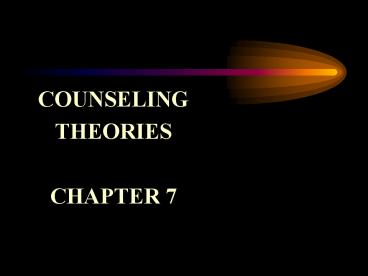COUNSELING - PowerPoint PPT Presentation
1 / 44
Title:
COUNSELING
Description:
A. Psychodynamic Theory. based on psychoanalytic theory. created by Freud. behavior is the product of conflicts between the id, ego, and superego. 5 psychosexual ... – PowerPoint PPT presentation
Number of Views:151
Avg rating:3.0/5.0
Title: COUNSELING
1
- COUNSELING
- THEORIES
- CHAPTER 7
2
I. INTRODUCTION
- A. Definition of and Need for Counseling
- Counseling is a helping relationship that
involves one party who needs help, another party
that provides help, and a setting that allows the
process to occur. - Frequently, we are helping people deal with the
feelings or emotions surrounding a communication
disorder - We are also providing guidance
3
Often, I have found that
4
B. Guidance, Counseling, and Psychotherapy
- Psychotherapy is concerned with the treatment of
psychological abnormality - This is the province of trained counselors and
psychotherapists
5
Counseling
6
Guidance
7
II. THEORIES OF COUNSELING
- A. Psychodynamic Theory
- based on psychoanalytic theory
- created by Freud
- behavior is the product of conflicts between the
id, ego, and superego - 5 psychosexual stages
8
B. Client-Centered Theory
9
(Luterman, 2008) The counselor (you, the SLP)
needs to be fully present
- You have to be in touch with your own needs and
experiences - You enter into a therapeutic alliance with the
client so as to release the clients
self-actualizing drive - With the right therapeutic environment, the
clients self-actualizing drive will bubble up
and they will actively choose to make changes
10
- Step 1
- Step 2
11
- Step 3
- Step 4
12
Some multicultural clients might not like this
13
C. Behavioral Theory
- Scientists could not measure and document
outcomes of psychoanalytic and client-centered
approaches wanted measurement - Behaviorists focus on what is observable, with an
emphasis on environmental, external influences
14
(No Transcript)
15
(No Transcript)
16
(No Transcript)
17
(No Transcript)
18
D. Cognitive-Behavioral Theory
- Belief clients thoughts are key to his or her
feelings and actions - Counseling is a 3-step process
- change the clients thinking
- change the belief system
- change the behavior
19
Luterman (2008) states that
20
There are some irrational thoughts that can cause
pain to clinicians and clients
21
Mistakes are not OK, and I must be stupid to have
done thisits awful!
- This attitude severely limits peoples personal
and professional growth - Remember It is only a mistake if you do it a
second time
22
(No Transcript)
23
A cognitive therapist
24
- 1)
- 2)
- 3)
- 4)
25
For example hearing impaired client
- 1. So you dont want to wear your hearing aid
because youre afraid people will avoid you at
social gatherings. - 2.When you go to the party Sat. PM, see if you
think this is true. Observe peoples reactions to
you. - 3. (next session) How did people react? Oh, no
one avoided you? You had fun? - 4. Now that we know this, would you be willing
to wear your hearing aid more often?
26
(No Transcript)
27
E. Reality Therapy (Okun Krantrowitz, 2008)
- This is a branch of the cognitive-behavioral
theory - It was developed by psychiatrist William Glasser
- It is rational, logical, and learning oriented
28
Like a breath of fresh air. ?
29
8 Steps
- 1.
- 2.
- 3.
30
- 4.
- 5.
- 6.
31
- 7.
- 8.
32
F. Eclectic Approach
- 1) accept and listen to client nonjudgmentally
--let them express their emotions - 2) if feelings are accompanied by negative
thoughts that are preventing progress, help
client test experimentally the validity of those
thoughts - 3) help clients implement constructive behaviors
to deal with their communication disorder
33
Again, remember
34
III. DEALING WITH CLIENTS COGNITIVE
DISTORTIONS
- 1.
- 2.
- 3.
35
- 4.
- 5.
36
6. Should statements
37
7. Catastrophizing
- People believe the worst that can happen, and
that it will happen to them - If my child is retained in 4th grade, hell
become a behavior problem and maybe eventually
turn to a life of crime
38
- Mindsets that Inspire Procrastination
- 1.
- 2.
- 3.
39
- 4.
- 5.
40
Many Americans have low frustration tolerance
41
IV. REACHING RESOLUTION
- Sometimes people cannot come to a conclusion or
agree upon a course of action - In these cases, I use a little Roseberry magic
42
A technique I have sometimes used
- First present a solution thats really
unpalatable - We could not enroll Neil for stuttering therapy,
and just let him go. Of course, the danger is,
that when he gets to junior high, the other kids
might really make fun of him and ostracize him.
43
Next
- Present another unpalatable extreme
- I could see Neil daily for 20-30 minute
sessions, but he would always miss social studies
and probably fall behind.
44
Lastly
- Present a middle of the road option that is
very palatable - A third option is that I could see Neil twice a
week for 20 minutes, and send home brief
assignments for you to do with him. In this way,
he wouldnt miss too much class and we could work
on strategies for him to be more fluent,
especially as he goes into junior high. - Which one of these sounds best to you?































